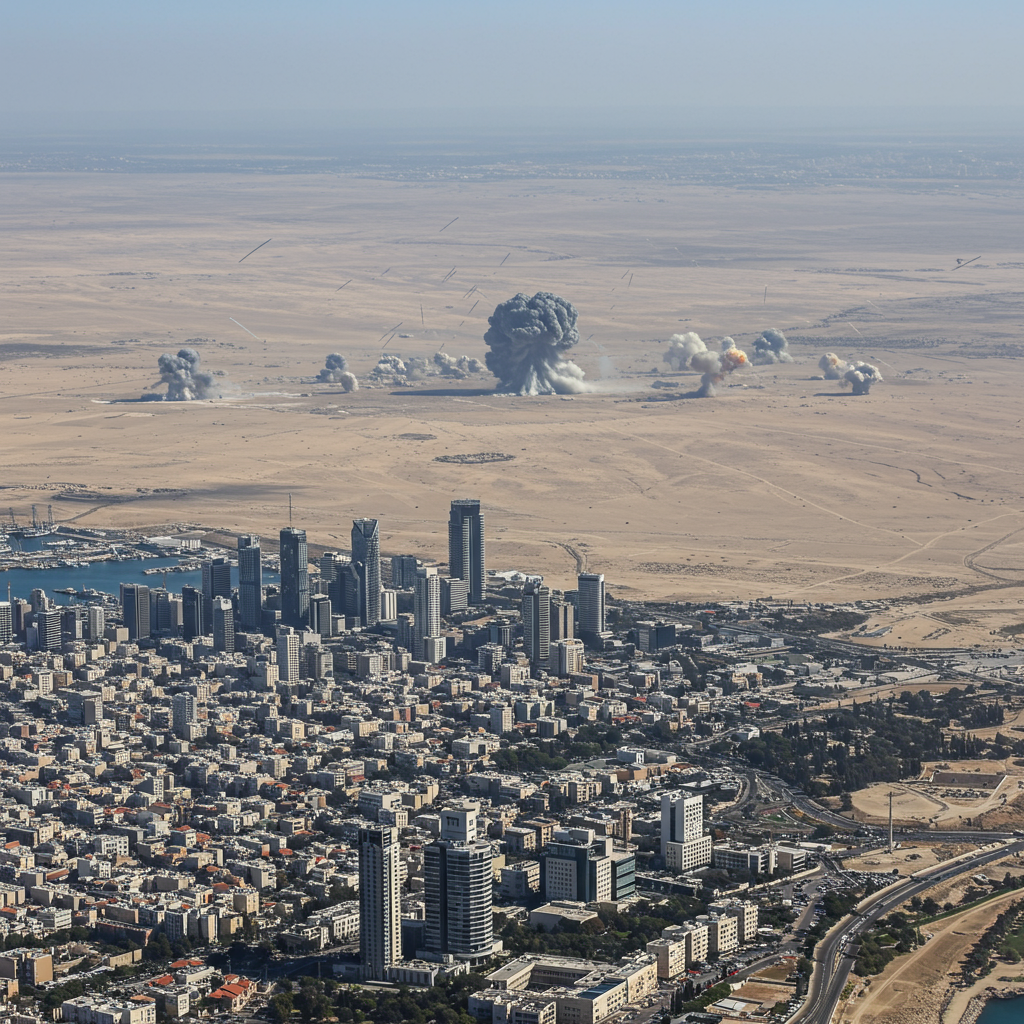War Day 620: Israeli Strikes Deep in Iran Intensify as Tel Aviv Avoids Disaster
On Day 620 of the ongoing conflict, the intensity of operations reached new heights, particularly with the Israel Defense Forces (IDF) executing extensive, deep airstrikes within Iran. Simultaneously, Israel faced renewed missile attacks, including a strike on Tel Aviv that, remarkably, resulted in no fatalities, described by some as a miracle. This day underscored the escalating nature of the conflict, marked by significant military advancements against Iran’s nuclear and military infrastructure alongside continued threats to the Israeli home front.
Adding to the context of these events, the preceding days saw significant exchanges, including an Iranian missile barrage on Day 619 that followed Israeli strikes and resulted in multiple casualties in Israel. This set a grim backdrop for the events of Day 620, where the outcome of one missile strike stood in stark contrast.
Human Cost:
53 held captive in Gaza.
31 confirmed murdered hostages held in Gaza.
148 living hostages rescued.
54 hostage bodies rescued.
1,881 Israelis killed (cumulative).
432 fallen soldiers and police in Gaza.
88 fallen soldiers in Northern Israel.
18 fallen soldiers and police in Judea & Samaria.
31,245 estimated projectiles fired at Israel (cumulative).
10,000 Israelis estimated remain displaced.
(Data sources primarily from public IDF and government updates.)
Escalation Deep Within Iran
Israeli military sources report significant progress in achieving strategic objectives within Iran. Within the first few days of this front opening, the IDF claims to have completed over 50% of its goals, with the original bank of targets – including critical nuclear and ballistic missile sites – expected to be addressed within a week. A monumental achievement highlighted is Israel gaining full aerial control over western and central Iran, including the airspace above Tehran. This control, previously anticipated as the conflict’s greatest challenge, is now facilitating real-time intelligence gathering and directed airstrikes from over a thousand miles away.
Targeting Iran’s Nuclear Ambitions
A primary focus of the deep strikes has been Iran’s nuclear program infrastructure. The Natanz uranium enrichment site, housing some 15,000 centrifuges crucial for enriching uranium, is reported by the head of the IAEA to have suffered severe damage or destruction from IDF strikes.
Further impacting the path to a nuclear weapon, the Isfahan uranium conversion facilities were also targeted. These sites are vital for the critical step of converting enriched uranium into metallic uranium, a component necessary for nuclear weapons. Strikes reportedly damaged facilities for enriched uranium reprocessing, metallic uranium production, laboratories, and other key infrastructure. Notably, Israeli officials reportedly refrained from directly striking the vast enriched uranium stockpiles located at Isfahan to prevent radioactive contamination risks, a detail aligning with international reports. The destruction of the conversion facilities temporarily halts Iran’s ability to process its enriched uranium into weapons material.
Attention is now squarely on the Fordow enrichment facility, a site deeply buried under a mountain near Qom. While smaller than Natanz, Fordow is where Iran enriches uranium to higher levels, including near weapons-grade. Although satellite imagery suggests defenses around Fordow may have been hit, direct strikes on the facility itself have not yet been publicly reported. Israeli officials have repeatedly stated Fordow is a target and will be dealt with, included in the “bank of targets” slated for destruction relatively soon. International discussion notes the potential for the U.S., with its specialized bunker-buster bombs (GBU-57A) and B-2 bombers, to destroy Fordow in a single strike, a capability Israel may lack.
Eliminating Iranian Military Leadership
Strikes have also significantly impacted Iran’s military command structure. An overnight strike targeted a secret emergency headquarters in Tehran, resulting in the elimination of Major General Ali Shadmani, the newly appointed chief of Iran’s military emergency command. His predecessor, Major General Gholam Ali Rashid, was reportedly killed just days prior, highlighting the rapid decapitation of key leadership roles. This strike is reported to have caused the remaining military leadership to flee and become largely dysfunctional, part of a broader Israeli claim that the vast majority of IRGC and Iranian Armed Forces top leadership has been eliminated.
Extensive Airstrikes and Impaired Capability
Israeli Air Force jets conducted widespread strikes across Iran, hitting targets in major cities including Tehran, Isfahan, Natanz, and others. One significant mission involved 60 IAF jets targeting ballistic missile launchers and other threats deep inside Iran. IDF reports indicate that Iranian forces have withdrawn from western Iran and are attempting to launch missiles from deeper within the country, though the IDF asserts there is “no hiding.”
Crucially, the IDF claims to have destroyed over 40% of Iran’s ballistic missile launchers, approximately 200 platforms. With an estimated 1,800 missiles remaining, destroying the launchers is paramount as they are essential for coordinated attacks. IDF assessments suggest this has significantly impaired Iran’s ability to conduct large-scale, coordinated missile strikes. Heavy strikes in Tehran specifically targeted military infrastructure and sites linked to nuclear projects, with plans for more significant regime targets to be hit. Evacuation warnings were issued for districts in Tehran with heavy regime presence, preceding airstrikes in those areas.
Iran’s Retaliation and the Tel Aviv ‘Miracle’
In response to the Israeli offensive, Iran launched multiple volleys of missiles throughout Day 620 and into the following night. While several impacts occurred, remarkably, there were no fatalities, though several individuals were injured.
One particularly striking incident involved a missile landing in a densely populated neighborhood in Tel Aviv. The missile hit a large vacant lot – reportedly the only such space within a 500-meter radius. This impact location, situated in the center of the lot and away from surrounding buildings, drastically limited the damage and prevented mass casualties. One resident described it as landing “precisely there,” far from buildings, minimizing the impact of the blast wave, which nonetheless shattered windows nearby. The site’s history, including a previous building that burned down exactly 39 years prior, added a layer of poignant coincidence to the “miracle.” Over 30 attack drones were also intercepted throughout the day and overnight. Emergency services continue to warn civilians to avoid impact sites due to potential explosive shrapnel.
Updates on casualties released today include four individuals killed in previous attacks: Yaakov and Desi Bello, Igor Fradkin, and Uri Levy. The resilience of the civilian home front, despite these attacks, was highlighted by IDF Chief of Staff Lt. Gen. Eyal Zamir during a visit to an impact scene.
Broader Conflict Landscape and International Reactions
Potential U.S. involvement remains a key factor. Reports indicate President Trump is signaling a shift towards possible military action against Iranian nuclear assets, moving away from diplomatic approaches and calling for “unconditional surrender.” The U.S. is reportedly deploying defense systems to the region to protect its assets and stationing heavy bombers, potentially targeting Fordow if intervention occurs. However, this carries significant risk, as Iran is reported to have prepared missiles specifically to target U.S. bases if they enter the conflict.
Internationally, Germany has voiced strong public support for Israel’s actions. Chancellor Friedrich Merz stated that Israel is performing “the dirty work for all of us” against a “terrorist regime” that could potentially acquire nuclear weapons, adding that Germany is also a victim of the Iranian regime.
Internal dynamics within Iran are also under scrutiny. Crown Prince Reza Pahlavi, widely seen as a leader of the Iranian opposition abroad, continues to call for the overthrow of the regime, claiming it is near collapse and that plans for a democratic transition are in place. Unverified rumors circulate regarding potential secret support from some Iranian generals.
Adding another layer to the pressure on Iran, a hacking group known as “Predatory Sparrow,” previously linked to Israel, claimed responsibility for a cyberattack that reportedly destroyed data at Iran’s US-sanctioned Bank Sepah. The group accused the bank of funding regime activities, an attack confirmed by Iran’s Fars News Agency, which reported disruptions to services.
Updates from Other Fronts: Gaza and Lebanon
Operations continue in Gaza, with four IDF divisions actively working to dismantle remaining Hamas infrastructure, including tunnel networks. Significant advancements are reported, including the encirclement of Jabaliya and operations in the eastern outskirts of Gaza City and the Netzari Corridor. Evacuation warnings were issued for most remaining areas of Khan Younis as Division 36 prepares for a major push there.
A notable operation involved filling tunnels discovered under the European Hospital with cement. This method was chosen to avoid collapsing the hospital structure above, unlike conventional explosive destruction. The Gaza Division (143) maintains control of key areas like Rafah and continues clearing operations.
Humanitarian aid continues to enter Gaza. On the preceding day, 64 trucks were transferred, and today, the Gaza Humanitarian Foundation (GHF) distributed over 3 million meals. The GHF denied media reports of casualties at its distribution centers, clarifying that incidents occurred near UN locations and emphasizing the security provided by American contractors at GHF sites. Occasional, ineffective rocket fire continues from Gaza, primarily landing in open areas without triggering sirens.
On the northern border, the threat posed by Hezbollah remains. Two IDF brigades have been mobilized as a precaution. While Hezbollah rocket fire hasn’t been a major factor this day, reports indicate Hezbollah is preparing to potentially join the war if requested by Iran. The IDF has continued targeting Hezbollah terrorists engaged in military activity in Southern Lebanon.
The day’s events underscore the multifaceted nature of the conflict, with major strategic moves unfolding deep inside Iran, simultaneous defensive battles and humanitarian efforts in Gaza, and simmering tensions on the Lebanese border, all set against a backdrop of international diplomacy and potential further escalation.
—
WATCH:
Israeli fighter jets destroy Iranian defenses in real time.
Heavy bombing of regime buildings in Tehran today.
Airstrikes in district 18 in Tehran where the IDF warned civilians to evacuate.
The site of a miracle—where a missile landed in a rare empty lot in urban Tel Aviv.
Interceptions over Israel.
- An Iranian missile had a direct impact on a building in the Arab town of Tarqumiyah.
- anash.org
- www.haaretz.com




